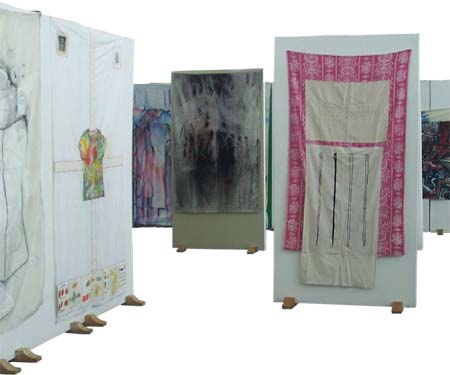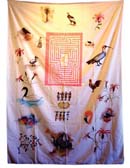
The Traces: The Private Eye exhibition is an initiative thought out by artists who set up a company for the registration and transfer of the personal stamps of their works out of the artistic scene each and every one of them hails from. At his point, their autonomy statement points to the preeminence of the face as a configuration map of identity tensions that move beyond the homogeneities and discontinuations that weave into symbolic knots of corporal representations in cultural scenarios seriously damaged by State-run strategies that aim at doing in the very notion of citizenship.
The art exposed here knits together a patchwork of formal decisions that share a stubborn fascination for what I’ll now call the shroud instance of the reparatory discourse. In this particular field, either through copies or by simple autographic execution, the representation underscores the desire to graphically collect the body residues, as if it were a gauging of intensities that reproduces the eccentric of each and every one of them in an articulation of local scenes submitted to esthetic preventions and materials of different consistence.
Let’s talk about scenes. It’s all about minimal institutional configurations whereby the mythical story about the origin of the practices is told, a yarn-spinning narration that gets whipped into shape through combined discontinuities. Contemporariness is not homogeneous and never gets cranked up simultaneously, let alone that mountings, framings and localizations do nothing but mark off the scope of the intervention of significant graphic developments. In the discourse, they seem to be equally valued: Posadas, Cabichui, la Lira Popular. In materiality, though, national paintings diversify as if they were dissipative analogies of the landscape, of the telluric forces, of the industrial epic poems turned into maps of symbolic relations.
The differentiated provenience of artists whose artworks have been culled and exhibited at the San Marcos de Lima Cultural Center, followed by the El Cabildo Cultural Center in Paraguay’s Asuncion, the Museum of Contemporary Art in Valdivia and finally at the Regional Arts Center of Zamora (Mexico’s Michoacan), buttresses a decisive moment in the minority reading of inter-zone relationships. These are the spaces in which the artists’ initiatives go the public policies one better and show the road ahead based on the in-built diagrams their works of art display. In this sense, they state the prevalence of the private eye over the public eye, the former construed as the framing that holds the existence of individual initiatives, while the latter is submitted to the programmatic authoritarianism of the cultural institutions.
The private eye is a style affect forged in the den as a formal retraction situation. It’s worth to point out that Antonio Guzman, Pate, Patricio Bruna, Victor Hugo Bravo, Isabel Montesinos, Hector Siluchi, just to name but a few Chileans, come all from Valparaiso, a seaport whose spatial configuration and history of neighborhood decline provide artists with spaces they can call their own for retraction, and even a certain self-referential character that sometimes stand up against it. Artists fall back on their quarters and abstain themselves from establishing open social ties. They rather develop practices that make imaginary defense accrue and beef up their not pertaining to a real circuit.
The public eye, in turn, gives way to a kind of “soft” authoritarianism that appeals to the dissolution of individual initiativesand finds shelter in the mythology of “the collective” that, at the end of the day, is nothing but a model of mutual surveillance that stands in the way of critical interlocution. Nonetheless, the lifestyle of local artistic communities is marked by a genuinely special moment dubbed the “logic of the clinamen”, a
drive into productive laterality that generates new dynamics out of deviation. That was the core of Antonio Guzman’s operative work in Valparaiso, first back in the 1990s and based on the self-defensive experience of the private eye that left a stamp of its own and can now been seen in this exhibition as an effect of this self-productive devise.

In fact, back in the 1990s a group of artists from Valparaiso –all painters–were suffering from exclusion for both being painters and for living in Valparaiso, victimized by the discriminating hegemonies of the metropolitan fine arts, that is, the one that was going on in Santiago. However, we must accept the hypothesis that in the countries this exposition has been seen quite a similar situation is going on: the local scenes are discriminated against by the hegemonic production that dominates the markets and rules the distribution of a minimal legitimization rating. Thus, back in the 90s this bunch of painters proclaimed itself the group of the Portuguese painters who pintaban-paisajes-por-poca-plata-para-poder-pasar-por-parís (painted landscapes for a few bucks just to travel to Paris).
The joke of the 90s led to the concretion of an organic desire supported by the willingness of self-produced inscription from the boundaries of the official scene. The only program that bound them together was the order of the affective complexity of an expanded self-defense that cottoned on to the need of stepping out of the den and forging ties among artists. That is, formal work initiatives with a view to piece together a platform of subordinated circulation. But the fact of the matter is that a decade later Antonio Guzman himself looked for some members of that former experience and summoned them to put on a show that could gather the conjunction of heterogeneous forms of minority survival, even though the artists he called upon –not all of them– take an eccentric position in relation to the predominance of the artistic creation in their own countries. Making comparisons will really be somewhat annoying.
From the standpoint of the organic accumulation of strengths, only asymmetric alliances can be forged in order to come up with spaces of recognition that do not depend on dominant markets or on the distribution of institutional legitimizations. There are other fields, other forms of letting creations make the rounds, other ways of sharing alleged dislocated formals.
Only by doing this Antonio Guzman could “invent the powder” to rekindle a circulation experience from the edges. He always was an expert in coastal navigation and that includes a slight resiliency to sail past reefs, threatening cliffs and shallow-water bays that oppose the hardened regulations dictated by the transcontinental vessels. Someway, what he’s done is a repetition of the phrase “we’re all Portuguese painters” by collecting a number of soft-material artworks, as if they were the dog-eared sails of archaic ships that were useful during the commercial years and have now been forced out of the market to serve merely as shrouds in the funeral arts. Thus, what these pieces of cloth convey are the memories of bodies that have always been present in the ghostly inventories of the heart-wrenching pain. But as in Ricardo Migliorisi’s paintings, they mend the willingness of the bodies to execute their function of coverage providers, as if the organic residues were nothing but the replaced letters that get shaped on the sheets, overloaded by the knowledge materialistically projected by oblivion. It’s like the public eye negotiating the negation of the desire and making figural frustration a policy of representation.
Traces: The Private Eye. An exhibit of conjugal emblems displaced and turned into insignias that reveal the origin of the facial, as if these contemporary pictorial practices were nothing but a declination of the shroud that covers the Vero Icon. I can’t help it but I need to mention Watteau’s painting entitled A l’enseigne de Gersant, in which some store clerks remove –or pack- the image of the monarch. Is the image actually needed? The packing box acts as the metonymy of a casket in which the desire likened to the dissemination of the image as an insignia rests. We do nothing but go back to square one as far as the same problems are concerned. What really stands between Watteau and Zurbaran is the unfolding and folding process that determines the conditions of a cartography associated to the power of representation.
July, 2009
Related Publications

How Harumi Yamaguchi invented the modern woman in Japan
March 16, 2022












